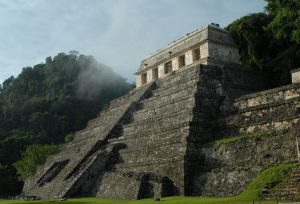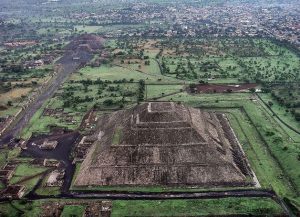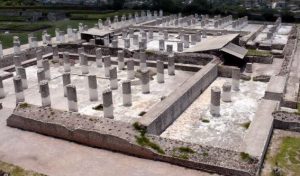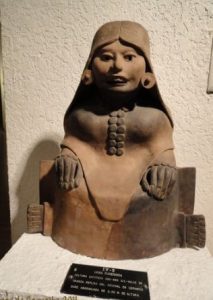The Ancient civilizations of Mexico are known as Prehispanic Cultures of Mexico or the Pre-Columbian Mexican civilizations, those which achieved the most profound cultural development in the Americas. The Mesoamerican region accommodates the most advanced and complex civilizations of the American continent which developed over many centuries before the arrival of the invading Spanish “conquistadors.” The main Mesoamerican Prehispanic cultures of Mexico are: the Olmec Culture, Teotihuacan, Toltec, Zapotec, Maya, Aztec, Mixtec, and the Chichimec peoples, among others.

Ancient Civilizations of Mexico
Contents
Definition of Prehispanic America and Pre-Columbian America
Prehispanic America (covers the events before the arrival of the Spanish) and Pre-Columbian America (covers the events before the arrival of Christopher Columbus) are terms which are sometimes used as synonyms, but should not be generalized as many North American Amerindian peoples belong to Pre-Columbian America but not to Prehispanic America as they were not colonized by the Spanish but by Anglo-Saxon Europeans. Prehispanic America would include nearly all of Latin America. The term Prehispanic America is commonly used in Spanish-speaking countries. Conversely, the term Pre-Columbian America includes all the Amerindian peoples without regard to the origin of their conqueror, whether Spanish, French, Anglo-Saxon, Portuguese, Dutch, etc.
History of the Ancient Civilizations of Mexico
Many Pre-Columbian civilizations established varied cultural characteristics like the formation of permanent urban settlements, utilization of agriculture, civil and monumental architecture, also the formation of complex social hierarchies. Some of these Pre-Columbian cultures had already disappeared before the arrival of the first European colonizers (end of the 15th Century – and the beginning of the 16th Century) and because of this are scarcely known by archaeologists. Other American cultures were contemporaries of the events which unleashed the conquest of America and are known through the historical accounts of the time.
Some cultures, like the Mayas, had their own systems of writing in which they recorded the events of their history. However, the majority of these texts, Pre-Columbian codices, were destroyed by the Europeans, who saw them as heretical for Christianity. Some secret documents would barely survive intact and would serve for modern investigators in the study of Pre-Columbian Mesoamerican cultures in general.
The Mayas

*The Mayan civilization began between 600 and 400 B.C in the lower forested regions belonging to what are now the territories of Guatemala, Belize, and southeast Mexico.
Even though it lasted until the Spanish conquest at the beginning of the 16th Century, it reached its peak during the classical period (200-900 A.D.). In contrast with Teotihuacan, the Mayas did not create a unified political structure but formed a certain number of city-states with a common culture. Their artistic forms, scientific knowledge, and monumental architecture made the Mayas the most civilized people of the American continent in many aspects.
At the beginning of the classical period (around 250-300 B.C.), the Mayas entered the most elevated period of their civilization. At that time various Mayan city-states competed to govern the low southern regions, and dominate their respective territories. Among these cities were Palenque, Piedras Negras, Yaxchilan, Altar de Sacrificios, Seibal, Dos Pilas, Tikal, Uaxactun, Altun Ha, Caracol, Quiriguá, and Copán. Like other Mesoamerican societies, the Mayas were ruled by a noble class which monopolized political and religious power. The smallest cities paid tributes to the governors who resided in the main urban centers.
The first of the main Maya centers of the classical period was Tikal, set deep in the forested area of the Petén Department, in the north of Guatemala. Tikal raised its first stela (monument) in 292 A.D. and during the following 200 years dominated a large part of the lower regions.
Keep reading about the Ancient Maya civilization
The Olmecs
Olmec is the name received by a culture which developed in Mesoamerica during the Middle Pre-classic period. Even though indications of their presence have been found in wide zones of this cultural area, it is considered that the nuclear Olmec area —or metropolitan zone— includes the southeast part of the state of Veracruz and the west of Tabasco. The specific ethnic connection is unknown to science —that is, who the descendants of this people are—, although there are numerous hypotheses which have tried to resolve the mystery of the identity of the Olmecs. In this sense, it is necessary to make the clarification that the ethnonym Olmec was given to them by archaeologists of the 20th Century, and they should not be confused with the Olmeca-xicalancas, who were a group which flourished during the Epiclassic period in parts of central Mexico like Cacaxtla.
For a long time, it was considered that the Olmecs were the mother culture of Mesoamerican civilization
It is estimated that the oldest indications of the Olmec culture are around 1200 B.C., and the most recent are from approximately the year 500 B.C. The Olmec civilization consisted mainly around 3 ceremonial centers: San Lorenzo, La Venta, and Tres Zapotes, in addition to showing itself at other sites like Laguna de Los Cerros.
The oldest recorded Olmec center is that of San Lorenzo (1150 B.C. approx.), situated in the basin of the Coatzacoalcos river, in the state of Veracruz. The beginning of the flourishing of the Olmec culture at this location began around the year 1150 B.C., the era to which the greater part of the sculptures and architectural elements which characterize the Olmec culture are dated, many of which are preserved at this location. San Lorenzo was sacked in the year 900 B.C., and the monumental sculptures endured an attempt to destroy them; some were buried, and others were moved to the ceremonial center of La Venta.
 La Venta is the largest ceremonial center and is outlined on a North-South axis. A great number of tombs have been found with very rich furnishings, with ceramic and stone figurines. Colossal heads and thrones have also been found. It is believed that it was able to hold up to 18,000 inhabitants. It suffered a great decline and was abandoned and destroyed, although the reasons are unknown.
La Venta is the largest ceremonial center and is outlined on a North-South axis. A great number of tombs have been found with very rich furnishings, with ceramic and stone figurines. Colossal heads and thrones have also been found. It is believed that it was able to hold up to 18,000 inhabitants. It suffered a great decline and was abandoned and destroyed, although the reasons are unknown.
The ceremonial center of Tres Zapotes was the last to develop. It is the most known because it was the one which survived to the time closest to our own, but the Olmec culture which developed here was a culture already in decline, not the splendor which lived in the earlier ceremonial centers.
These ceremonial centers had the function of cities, and in them were constructed buildings of earth and adobe, because of which very few remains have lasted. Mounds were built with temples on the higher part, which could be considered a precursor of the Mesoamerican pyramids. They also constructed buildings around central courtyards, characteristic of the later civilizations of the area. From the year 900 B.C. there is evidence of brusque political changes, as shown by the attempt to destroy some of the Olmec heads.
Teotihuacan

Teotihuacan (Nahuatl: Teōtīhuacān, ‘City of the gods’ ) is the name given by the Mexicas to the most populated urban center of Mesoamerica and that of the greatest peak during the Classical period and currently an archaeological zone located in the valley of the same name, which forms a part of the Mexico Basin. It is at a distance of 40 kilometers to the northeast of Mexico City and forms a part of the municipalities of San Juan Teotihuacan and San Martín de las Pirámides, in the northeast of the state of Mexico. Although the city came to have a surface of approximately 21 km2, currently the set of archaeological monuments which is found open to public view represents approximately one tenth of the original city. It came to count a population of between 150 and 200 thousand inhabitants in its era of greatest splendor.
Since the Mesoamerican period, the city of Teotihuacan was an object of interest to the peoples who succeeded the Mexicas in Mesoamerica. In the Great Temple of Mexico-Tenochtitlan, numerous relics of Teotihuacan origin have been discovered, because of which the conclusion has been reached that the Mexicas themselves were among the first explorers of the archaeological site. It was not until the end of the 19th Century that the most outstanding monuments were restored: the bases today known as the Pyramid of the Sun and Moon, located in the vicinity of the Calzada de Los Muertos, called this by investigators at the beginning of the 20th century.
Teotihuacan was added to the list of World Heritage Sites by UNESCO in 1987. It is the archaeological zone with the highest influx of tourists in the country, over sites like Chichén-Itzá or Monte Albán. In spite of what could be considered a great quantity of restored monuments at the site, archaeological excavations at Teotihuacan continue to this day, and have given as a result a gradual increase in the quality and quantity of knowledge which is had about this city, of which, certainly, questions as important as the original name and the ethnic affiliation of its founders are unknown. It is known, in contrast, that it was a cosmopolitan site, by the documented presence of groups which came from the Gulf Coast or the Central Valleys of Oaxaca.
The Toltecs
Upon the fall of Teotihuacan, various populations of the Basin of Mexico went to other regions in search of new land. This was the case of the Toltecs, who arrived at Tulancingo, where they stayed for four years, later they moved to a place which was located next to the Tula River. This is where they would erect the ‘Tollan-Xicocotitlan’ of which the historical sources tell us (in the current municipality of Tula de Allende, in the state of Hidalgo, Mexico).

The demonym is derived from the Nahuatl “toltécatl,” which originally designated the natives of the places called Tollan, but which later, during the Mexica era, became a synonym for artisan or artist.
The capital of the Toltec culture: Tula
The city of Tula (Tollan) is found on a promontory which dominates the Tula River and presents good defensive conditions. Streets and roads arranged the city. Social differences were reflected in the size, distribution and construction material of the houses, from those which were raised on a system of platforms near the monumental center, to groups of apartments or three-room houses around a common central courtyard in the shape of an L, where domestic and ritual activities were realized. There also existed neighborhoods which shared productive activities and ceremonies in a collective temple.
Its population, of about 60,000 inhabitants, was disseminated in peripheral zones and lived on agriculture, the extraction of basalt, the production of utensils and working with obsidian.
It is estimated that the history of Tula (Hidalgo) lasted from 900 to 1168 B.C. It exercised power over less advanced peoples and formed alliances, as in the case of the foundation of the province of Tula-Jilotopec.
Tula was the capital of the militaristic Toltecs. It possessed and austere society of warriors more interested in function than in form, such that they produced few luxurious objects. In spite of this, their development was contrasted with that of the other cultures of the Altiplano, because of which the Mexicas, upon establishing themselves in Tula later on, thought that these people were Toltecs or true artisans.
One group of them, upon the fall of Tula, left in exile and with their lord Nauhyotzin they settled in Culhuacan. From there princesses and nobles went out and intermarried with the Mexicas. The last ruler of Tula, Huéniac, ended his days by committing suicide, according to one historical source.
To this period belongs the type of open square with an altar in the center; one climbs to the altar by a stairway decorated with friezes on each side; the high walls are inclined, or sloped, and topped with prominent cornices.
To one side of the square was constructed a great pyramidal base, composed of several inclined superimposed sections, lined with slabs arranged in rows of four. To the side was constructed a building with a square floor and porticoes held up by pilasters covered with slabs. The porticoes were contiguous to the main buildings, which enclosed one side of the square.
 The main building is the one called the Temple of Tlahuizcalpantecuhtli (Venus as lady of the dawn, the Morning Star), which is a base composed of several superimposed parts, formed by low inclined walls, or high and sloped cornices or slabs, with a decoration in relief, on a stucco base, in which processions of jaguars and coyotes in opposite directions dominate, eagles eating human hearts and the effigy of the man-bird-snake, that is to say of the god Quetzalcoatl.
The main building is the one called the Temple of Tlahuizcalpantecuhtli (Venus as lady of the dawn, the Morning Star), which is a base composed of several superimposed parts, formed by low inclined walls, or high and sloped cornices or slabs, with a decoration in relief, on a stucco base, in which processions of jaguars and coyotes in opposite directions dominate, eagles eating human hearts and the effigy of the man-bird-snake, that is to say of the god Quetzalcoatl.
In the upper part, a temple was raised which had in the facade two columns in the shape of a serpent, with the head facing downward and the tail facing up, which held up the architraves. The rest of the temple had four high pilasters, adorned with figures of warriors with atlatls or spear throwers, darts, shields, and chest-pieces in the shape of a butterfly; symbols of the earth and other motifs.
Behind this building, there was a high wall, topped with conch shells cut in half (symbol of the wind) and a wide frieze decorated with bas-reliefs and topped with fretwork borders. The fundamental motif was a snake gobbling up a skeletal being (symbolizing the Earth swallowing Venus).
The Aztecs
The Aztec-Mexicas established military alliances with other groups, obtaining an empire that extended from central Mexico to the present border with Guatemala.
As they increased in numbers, the Aztecs established superior civilian and military organizations. In 1325 they founded the city of Tenochtitlan located in the present city of Mexico.
 The Aztec culture had advanced agriculture that served as sustenance for an enormous population. The main crops were corn, tobacco, chilies, fruit and maguey. They built immense buildings of grand design and stood out in different branches of art. They worked with metals, though they did not know iron. Since they did not have any suitable traction animals, they did not use the wheel as a driving element.
The Aztec culture had advanced agriculture that served as sustenance for an enormous population. The main crops were corn, tobacco, chilies, fruit and maguey. They built immense buildings of grand design and stood out in different branches of art. They worked with metals, though they did not know iron. Since they did not have any suitable traction animals, they did not use the wheel as a driving element.
Generally, we know as Aztecs the inhabitants of the territories conquered by Hernan Cortes, applying, therefore, that term not only to the own Aztecs but also to the Mexicas.They spoke a language called Nahuatl. Writing mixed pictograms, ideograms and phonetic signs. Their writings reflect their own history, geography, economy, religion. Some codices have reached our days.
Mixtecs and Zapotecs
The term Mixtec is actually a Nahua-Aztec word. The Mixtecs called themselves Nuudzahui or “People of the Rain” in their own language.
They inhabited the region of Oaxaca. The Mixtecs occupied the north and the Zapotecs the south and the east. They were related to the peoples who dominated the Otomies. They lived separately and dominated their neighbor tribes. Later on, they unified. They were very religious. Their priests were powerful. The Mixtecs worshiped Yoztalpépetl which means “Heart of the people.” The god of the Zapotecs was Pitao and had various personalities: Pitao Cocobi, god of the harvests; Pitao Cociyo, god of rain; Pitao Cozaana, god of hunting and fishing.
The Mixtec-Zapotecs were good architects. The palace temple of Mitla is formed of several parts similar to the Maya monuments, with geometric drawings in relief. The fretwork courtyard is notable. Monte Albán, the city of sepulchers, has temples, cities, courtyards and a multitude of sculptures of diverse gods. It was a fortified city for times of danger.
Monte Albán is a necropolis or “city of the dead.” In the excavation of the graves, Alfonso Caso, a notable archaeologist, discovered jewels which drew the attention of the whole world. Some of these jewels are preserved in the Oaxaca Museum. They worked with gold and silver and made jade inlays.
They practiced “Nahualism”
Nahualism means the worship of animals. The tribes, clans, and individuals had a protector animal. Every child that was born was consecrated to the animal to which the day of their birth was dedicated in the calendar. They practiced the worship of the dead. They believed in the immortality of the soul. To venerate their dead ancestors they constructed small temples over the tombs and in them deposited food and objects dear to the person buried there.
The Mixtec-Zapotec Culture

They made beautiful ceramic pieces. They carved stones, especially jade, to which they attributed magical virtues and which they used for jewelry, mosaics, and stelas. They adorned their temples and palaces with paintings and sculptures. They learned from the Mayas the scientific culture they reached: numeration, Geometry, Astronomy, calendars. The Mixtec-Zapotec culture is intermediate between the Maya and that of the Anahuac Valley (the Valley of Mexico) and its characteristics are the worship of the dead, jewelry and working with jade.
Illustrious kings of the Mixtec-Zapotecs
Tzahuindanda, who the legend says took from a sack as many warriors as he wanted. Zaachila I, defeated Condoy the great leader of the Mixtecs and Annexed these people to his reign. Cocijoeza conquered Tehuantepec and defended it from the Aztecs; he married Coyolicatlzin, daughter of Ahizotl, king of Tenochtitlan. Cocijopij, son of Cocijoeza and Coyolicatlzin, moved the capital to Tehuantepec and was the last independent king. In his time the Mixtec-Zapotecs voluntarily submitted themselves to the Spanish.
Foundation of the kingdom of Tilantongo (Mixtec legend)
A numerous Mixtec tribe did not have any lands. One of their warriors led them to the country of Tilantongo, which they took as their own. But a fiery sun embraced it and the Mixtec warrior thought that this place belonged to the sun. He climbed the highest mountain, challenged the sun to single combat and shot his entire quiver of arrows. The sun sank behind the distant hills among blood-red clouds. He was vanquished. The Mixtecs proclaimed as king the victor of the sun with the name “The Archer of Heaven.”
